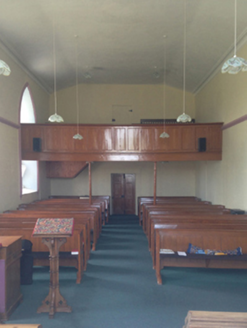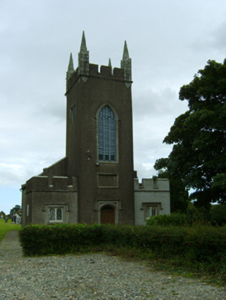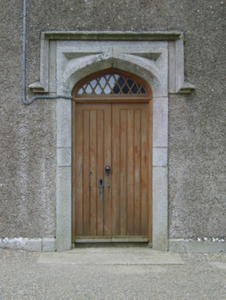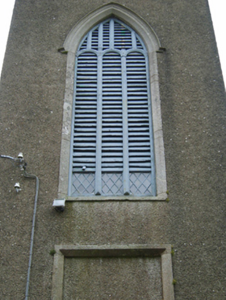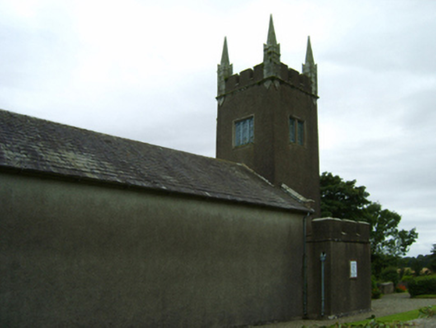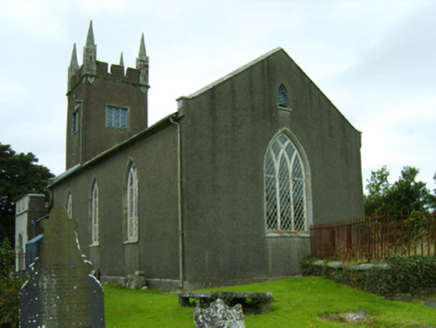Survey Data
Reg No
15701631
Rating
Regional
Categories of Special Interest
Architectural, Artistic, Historical, Social
Original Use
Church/chapel
In Use As
Church/chapel
Date
1820 - 1825
Coordinates
311971, 146266
Date Recorded
08/09/2007
Date Updated
--/--/--
Description
Detached three-bay double-height single-cell Board of First Fruits Church of Ireland church, built 1824; consecrated 1828, on a rectangular plan with pair of single-bay single-storey vestries centred on single-bay three-stage tower to entrance (west) front on a square plan. "Restored", 1999. Pitched slate roof with lichen-covered ridge tiles, cut-granite "saddleback" coping to gables on fine roughcast kneelers, and cast-iron rainwater goods on cut-granite eaves retaining cast-iron downpipes. Fine roughcast battered walls on rendered chamfered plinth; fine roughcast surface finish to tower on cut-granite chamfered plinth with cut-granite "Cavetto" stringcourse (bell stage) supporting cut-granite octagonal pinnacles centred on battlemented parapets having cut-granite "saddleback" coping. Pointed-arch window openings with carved timber Y-mullions, and cut-granite surrounds having chamfered reveals framing fixed-pane fittings having cast-iron lattice glazing bars. Pointed-arch window opening to chancel (east) with carved timber interlocking Y-mullions, and cut-granite surround having chamfered reveals framing fixed-pane fittings having cast-iron lattice glazing bars. Tudor-headed door opening to tower with granite flagged threshold, and cut-granite surround having chamfered reveals with hood moulding over framing replacement timber boarded or tongue-and-groove timber panelled double doors having overlight. Square-headed blind opening (second stage) with cut-granite surround having chamfered reveals framing fine roughcast infill. Pointed-arch opening (bell stage), cut-granite surround having chamfered reveals with hood moulding over framing applied timber mullions over louvered timber fittings. Interior including vestibule (west); square-headed door opening into nave with timber panelled double doors; full-height interior with timber panelled choir gallery (west) on colonette pillars, carpeted central aisle between timber pews, timber panelled pulpit on an octagonal plan with timber clerk's desk, stepped dais to chancel (east) with turned timber balusters supporting carved timber communion railing centred on cloaked altar below "East Window", and moulded plasterwork cornice to vaulted ceiling. Set in landscaped grounds with rendered piers to perimeter having cut-granite shallow pyramidal capping supporting spear head-detailed wrought iron double gates.
Appraisal
A church erected with financial support from the Board of First Fruits (fl. 1711-1833) representing an integral component of the early nineteenth-century ecclesiastical heritage of County Wexford with the architectural value of the composition, one recalling the contemporary Saint Eigneach's Church (Killegney) (1825-7), Castleboro Demesne (see 15702510), confirmed by such attributes as the standardised nave-with-entrance tower plan form, aligned along a liturgically-correct axis; the "pointed" profile of the openings underpinning a Georgian Gothic theme with the chancel defined by an elegant "East Window"; and the slender pinnacles embellishing the tower as a picturesque eye-catcher in the landscape. Having been reasonably well maintained, the elementary form and massing survive intact together with substantial quantities of the original fabric, both to the exterior and to the vaulted interior where contemporary joinery; a restrained wall monument commemorating Edward James Bolton (d. 1886) of Ballinastraw House; and sleek plasterwork refinements, all highlight the modest artistic potential of a church making a pleasing visual statement in a rural village street scene.
